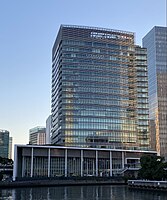
Photo from wikipedia
Growing evidence suggests that non-motor symptoms (NMS) in Parkinson’s disease (PD) have differential progression patterns that have a different natural history from motor progression and may be geographically influenced. We… Click to show full abstract
Growing evidence suggests that non-motor symptoms (NMS) in Parkinson’s disease (PD) have differential progression patterns that have a different natural history from motor progression and may be geographically influenced. We conducted a cross-sectional analysis of 1607 PD patients of whom 1327 were from Europe, 208 from the Americas, and 72 from Asia. The primary objective was to assess baseline non-motor burden, defined by Non-Motor Symptoms Scale (NMSS) total scores. Other aims included identifying the factors predicting quality of life, differences in non-motor burden between drug-naïve and non-drug-naïve treated patients, and non-motor phenotypes across different geographical locations. Mean age was 65.9 ± 10.8 years, mean disease duration 6.3 ± 5.6 years, median Hoehn and Yahr stage was 2 (2–3), and 64.2% were male. In this cohort, mean NMSS scores were 46.7 ± 37.2. Differences in non-motor burden and patterns differed significantly between drug-naïve participants, those with a disease duration of less than five years, and those with a duration of five years or over (p ≤ 0.018). Significant differences were observed in geographical distribution (NMSS Europe: 46.4 ± 36.3; Americas: 55.3 ± 42.8; Asia: 26.6 ± 25.1; p < 0.001), with differences in sleep/fatigue, urinary, sexual, and miscellaneous domains (p ≤ 0.020). The best predictor of quality of life was the mood/apathy domain (β = 0.308, p < 0.001). This global study reveals that while non-motor symptoms are globally present with severe NMS burden impacting quality of life in PD, there appear to be differences depending on disease duration and geographical distribution.
Journal Title: Scientific Reports
Year Published: 2021
Link to full text (if available)
Share on Social Media: Sign Up to like & get
recommendations!